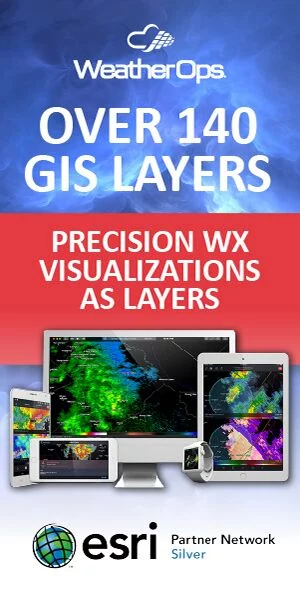RadarScope displays data from 30 radars operated by Environment Canada. These radars are based on different technology than the NEXRAD radars in the United States. The product suite is more limited, and the ground clutter is often more of a problem due to both technological differences and surrounding terrain.
Base Reflectivity
Doppler radars work by bouncing radio waves off particles in the air. Those particles could be raindrops, hail, snow, or even dust and insects. The amount of energy that bounces off of those particles and returns to the radar is called “reflectivity” and is represented by the variable “Z.” Reflectivity covers a wide range of signal strength, from very weak to very strong, so it is measured on a decibel (logarithmic) scale in units of dBZ or decibels of Z. The higher the dBZ value, the larger the number or size of the particles the radar beam is seeing.
The dBZ values increase as the strength of the signal returned to the radar increases. The scale of dBZ values is related to the intensity of rainfall. It is important to remember, however, that the radar shows only areas of returned energy and not necessarily precipitation. So the presence of a return, especially a very weak return below 20 dBZ, doesn’t always mean that it’s raining.
The colors along the bottom of the map correspond to precipitation types and intensities. When you move your cursor across the squares, RadarScope will display a value for each color. NEXRAD radars can’t distinguish between different kinds of precipitation with absolute certainty. However, reflectivity values can be somewhat roughly associated with varying types of precipitation:
- 10 dBZ (blue) – Very light rain or light snow
- 20 dBZ (green) – Light rain or moderate to heavy snow
- 30 dBZ (yellow) – Moderate rain or sleet showers
- 40 dBZ (orange) – Moderate to heavy rain or sleet showers
- 50 dBZ (red) – Heavy thunderstorms
- 60 dBZ (pink) – Intense to severe thunderstorms with hail
The Canadian base reflectivity product has a resolution of 0.5 kilometers and a range of 112 kilometers.
Long-Range Reflectivity
The Canadian long-range reflectivity product in RadarScope is synthesized from two products we receive from Environment Canada: a short-range reflectivity that filters out most ground clutter, and a long-range product with a 1-kilometer resolution that extends to 230 kilometers.
Precipitation Depiction
Precipitation Depiction is a proprietary WDT product combining super-res reflectivity data and surface observations to show a depiction of the current hydrometeor type. Rain is displayed using a somewhat traditional color palette for reflectivity, snow is presented in shades of blue, and wintery mix is shown in shades of red. The determination of rain, mix, or snow is an approximation based on multiple data sources and subject to error.
Base Velocity
Doppler velocity products indicate storm motion toward or away from the radar. The velocity products in RadarScope use the Doppler effect to determine how fast the particles in the air are moving relative to the radar itself. Negative values (green in RadarScope) indicate motion toward the radar, while positive values (red in RadarScope) indicate motion away from the radar. They can be difficult to interpret without training and experience, but Doppler velocity products can be used to detect the overall movement of a storm as well as relative motion within the storm itself, such as rotation. Note that the radar can only detect the component of the velocity vector along the radar beam, so this isn’t a full picture of the wind field. But it gives you a fairly good idea which way a storm is heading. The Canadian base velocity product has a resolution of 0.5 kilometers and a range of 112 kilometers.






